Assasif Tombs Egypt – Pabasa – Harwa – AnkhHor – Petamenophis – Kheruef – Puimre
Just a few of the El-Assasif Tombs in Thebes, Egypt.
“Whilst buying tickets to Hatshepsut’s temple at Deir el Bahri you may have noticed the sign giving ticket prices for the Assasif Tombs. Next time don’t ignore them they are well worth a visit. The Assasif is a very rich area for archaeologists and there are teams working at Petamenophis, Harwa and Puimra. The tombs that are open are Kheruef which is fully described here: http://www.touregypt.net/featurestories/kherueft.htm and Ankh Hor, which are on the same ticket and finally Pabasa, which is a separate ticket.”
http://touregypt.net/teblog/egyptologynews/?p=2311
http://touregypt.net/teblog/egyptologynews/wp-trackback.php?p=2311
[Retrieved on 07 Feb’ ’09]
Details on El-Assasif Tombs mentioned above:
Tomb of Kheruef [also called Senaa] (TT192) 18th Dynasty.
Steward to the Great Royal Wife Tiye, during the reign of Amenhotep III. The reliefs in the tomb contains depictions of Tiye, Amenhotep III (shown as a weak and elderly figure in some decoration)and Akhenaten (named as Amenhotep). Hence, its decoration program started late in the final years of Amenhotep III and the earliest phase of the Akhenaten’s reign.
The tomb of Kheruef is large enough to have several later tombs associated with it, or placed within its substructure. The tombs, TT189, TT190, TT191, TT192, TT194, TT195, TT196 and TT409 are all much smaller and largely undecorated.
Petamenophis [Padiamenope, Patuamenap or Pedamenopet] (TT33) 25th to 26th Dynasties.
Chief Lector Priest. This beautiful limestone fragment of relief comes from Tomb 33 at El-Assassif, belonging to Petamenophis. The portrait of this priest of modest rank, who owned one of the larger tombs of the Theban necropolis, has all the characteristics of the art of the transitional period of the 25th and 26th Dynasties. An archaic profile, individualised by large eyes with very marked eyebrows and by a thick-lipped mouth, is in particularly representative of it.
Video: http://www.clipser.com/watch_video/551446
Harwa (TT37) 25th Dynasty.
Harwa’s tomb is situated in the middle of the Assasif area, built on the processional way of Mentuhotep, with an entrance at the south. Archaeological excavations of the tomb began in 1995 and continue to-date. Harwa was an enigmatic person in ancient Egyptian history. He lived at the beginning of the 7th century BC, when the Nile Valley was in the hands of the Nubian Pharaohs of the 25th Dynasty. He held the position of Great Steward of the Divine Votaress, a position that allowed him to manage the huge resources of the state of Amun-Re of Karnak. This position was held for three centuries by the members of the clergy and embraced the whole southern Egypt. The importance of Harwa is mainly demonstrated by the eight statues portraying him in various attitudes which are now kept in the major Egyptian collections all over the world (Cairo, Aswan, Paris, London and Leipzig).
http://www.Harwa.it/eng/
Puimra [Puimre, Puyemra and also Puyemre] (TT39) 18th Dynasty.
The Ancient Egyptian noble and architect, Puimre was Second prophet of Amun during the reigns of Thutmose III and Hatshepsut. His tomb is located in El-Khokha, part of the Theban Necropolis, on the West Bank of the Nile.
http://www.uvmnet.edu/investigacion/episteme/numero4-05/colaboracion/a_preliminary.asp
Ankh Hor [Ankh-Hor, AnkhHor] (TT414) 26th Dynasty.
Ankh-Hor was ‘Steward of the Divine Votress Nitocris’, ‘Great Mayor of Memphis’, ‘Overseer of Upper Egypt in Thebes’ and ‘Overseer of the Priests of Amun’ during the reigns of Psamtek II and Apries (Wahibre) of Dynasty XXVI. His tomb is one of a series of large tombs in the Asasif area built at the end of the Third Intermediate Period for high officials in the estates of the Gods Wives of Amun. The great importance of the Gods Wives during this time is clearly reflected in the size of the tombs of their chief administrators, that of Ankh-hor being no exception. As Chief Steward of Nitocris, he would have been one of the most important and wealthiest men in Egypt.Ankh-Hor’s tomb followed the decoration in the tomb of Pabasa (TT279) and has some rare scenes of beekeeping, although the complete hives are not shown as they are in Pabasa’s tomb, but only the honeycombs.
(TT414) 26th Dynasty”]![ankhhor Ankh Hor [Ankh-Hor, AnkhHor] (TT414) 26th Dynasty](https://amenirdis.files.wordpress.com/2009/02/ankhhor.jpg?w=450) Pabasa [Pabes] (TT279) Ancient Egyptian noble Pabasa was Chief Steward to the Nitocris I, Divine Adoratrice of Amun, during the Saite Period – Twenty-sixth dynasty
Pabasa [Pabes] (TT279) Ancient Egyptian noble Pabasa was Chief Steward to the Nitocris I, Divine Adoratrice of Amun, during the Saite Period – Twenty-sixth dynasty
Pabasa has a large tomb at Asasif, just outside the entrance to Hatshepsut’s temple at Deir el-Bahri. Like Ankh-hor, who held this important title after him, he was the ‘Chief Steward of the God’s Wife Nitocris’ (Neitiqert) during the reign of Saite king Psamtek I.
Pabasa’s tomb still has a large mudbrick superstructure. A steep flight of stairs leads down to the entrance of the subterranean levels and on the lintel above the doorway is a fine relief of a barque, adored by the souls of Pe and Nekhen, by the God’s Wife, Nitocris and by the deceased.
A small vestibule leads to a larger pillared sun court. The vestibule shows scenes of Pabasa’s funeral procession, including mourners and the ‘Abydos Pilgrimage’. There is a long text of Pabasa and depictions of his son, Thahorpakhepesh, who acted as sem-priest at his father’s funeral.
On the inner lintel of the entrance to the court, a relief shows Osiris and Re-Horakhty, in the centre of a double-scene, with Pabasa and Nitocris and cartouches of the king (Psamtek I) and his daughter Nitocris on either side.
Beyond the sun court is a hall containing eight pillars, part of which was decorated but is now very damaged. The pillars were also decorated with deities and texts on the sides facing the central isle. At the rear of the hall a decorated niche contains Pabasa’s burial shaft. His granite sarcophagus is now in Glasgow Museum.
Several other chambers containing burial shafts are accessed from the rear of the hall.
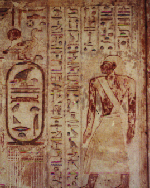
Pabasa - Pabes - Wall Relief
![pabasa-asasif-sarcophagus Pabasa [Pabes] (TT279) Sarcophagus](https://amenirdis.files.wordpress.com/2009/02/pabasa-asasif-sarcophagus.jpg?w=450&h=337)
———————————
http://www.Amunirdis.net/
http://www.Amenirdis.net/
http://www.Amenardis.net/
http://Queen.Amenardis.net/ – Main Blog
http://amunirdis.blogspot.com/
https://amenirdis.wordpress.com/
———————————
http://queen.amenardis.net/?p=123
http://queen.amenardis.net/wp-trackback.php?p=123
https://amenirdis.wordpress.com/2009/02/07/assasif-tombs-egypt-pabasa-harwa-ankhhor-petamenophis-kheruef-puimre/
https://amenirdis.wordpress.com/2009/02/07/assasif-tombs-egypt-pabasa-harwa-ankhhor-petamenophis-kheruef-puimre/trackback/
http://amunirdis.blogspot.com/2009/02/assasif-tombs-pabasa-harwa-ankhhor.html
http://amunirdis.blogspot.com/2009/02/assasif-tombs-pabasa-harwa-ankhhor.html#links

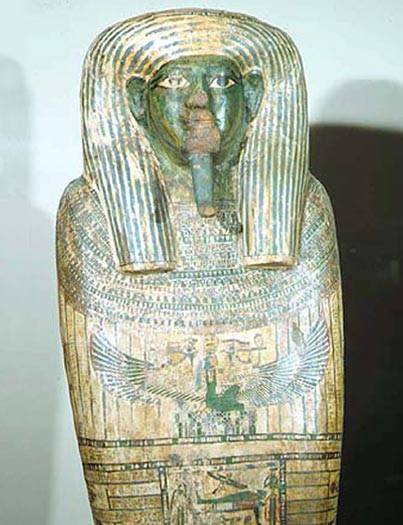

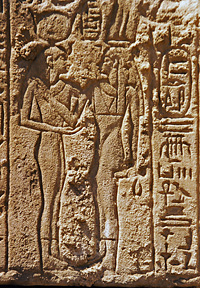 From Dynasty XXI onwards it was always the king’s unmarried daughter or sister who was given the title of ‘God’s Wife’ and the role became increasingly important. Maatkare, daughter of Pinudjem I is depicted as God’s Wife in the Temple of Khonsu at the southern side of Karnak. Her titles were ‘Divine Adoratrice, sole wife of the god’. Henuttawy, daughter of Pinudjem II is also depicted here. It was from this time on that the God’s Wives adopted a coronation name as well as a birth name. During the reigns of the Libyan kings, their sons were given the office of High Priest of Amun and their daughters the title of ‘God’s Wife of Amun’. Some of the daughters of Libyan Chiefs and Egyptian elite were called ‘Chantress of the Inner Abode of Amun’ and presided over a college of priestesses, which seems to have been a kind of upper class convent.
From Dynasty XXI onwards it was always the king’s unmarried daughter or sister who was given the title of ‘God’s Wife’ and the role became increasingly important. Maatkare, daughter of Pinudjem I is depicted as God’s Wife in the Temple of Khonsu at the southern side of Karnak. Her titles were ‘Divine Adoratrice, sole wife of the god’. Henuttawy, daughter of Pinudjem II is also depicted here. It was from this time on that the God’s Wives adopted a coronation name as well as a birth name. During the reigns of the Libyan kings, their sons were given the office of High Priest of Amun and their daughters the title of ‘God’s Wife of Amun’. Some of the daughters of Libyan Chiefs and Egyptian elite were called ‘Chantress of the Inner Abode of Amun’ and presided over a college of priestesses, which seems to have been a kind of upper class convent.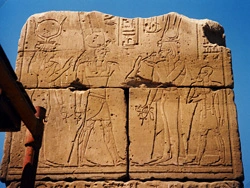 The second structure here is better preserved with some good reliefs. This is the (earlier) chapel of Ankhnesneferibre who was a daughter of King Psamtik II of the Saite Dynasty XXVI and sister of King Wahibre (Apries). We know from surviving texts that this lady arrived in Thebes at only seven months old (in 595 BC) and was eventually installed as ‘High Priest’ of Amun. The next structure is her later chapel which is larger still and originally had a four-columned hall and a sanctuary at the rear. Parts of the gates survive and reliefs of Ankhnesneferibre before various deities can be clearly seen, including cartouches of Kings Ahmose II and Psamtik III. In one of the reliefs she is followed by her chief steward and fan-bearer who is named here as Sheshonq. There are also some lovely depictions of a lion-headed cobra and a strange underworld deity with two duck’s heads.
The second structure here is better preserved with some good reliefs. This is the (earlier) chapel of Ankhnesneferibre who was a daughter of King Psamtik II of the Saite Dynasty XXVI and sister of King Wahibre (Apries). We know from surviving texts that this lady arrived in Thebes at only seven months old (in 595 BC) and was eventually installed as ‘High Priest’ of Amun. The next structure is her later chapel which is larger still and originally had a four-columned hall and a sanctuary at the rear. Parts of the gates survive and reliefs of Ankhnesneferibre before various deities can be clearly seen, including cartouches of Kings Ahmose II and Psamtik III. In one of the reliefs she is followed by her chief steward and fan-bearer who is named here as Sheshonq. There are also some lovely depictions of a lion-headed cobra and a strange underworld deity with two duck’s heads.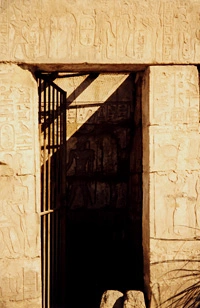 Next to Ankhnesneferibre’s chapel is another tiny shrine, also a chapel of Osiris Neb-ankh. This is like a little dolls-house, dedicated by the God’s Wife Shepenwepet (II), a daughter of King Taharqa of Dynasty XXV. Said to be perhaps the smallest religious monument in Egypt with a doorway only a little over a metre high leading to a tiny inner chamber, it is difficult to imagine any ceremony taking place here. There are some superb deeply-carved reliefs inside this little shrine with cartouches of Shepenwepet (II) and her sister the ‘God’s Wife’ Amenirdis, (II) as well as a cartouche inscribed for Osiris Neb-ankh.
Next to Ankhnesneferibre’s chapel is another tiny shrine, also a chapel of Osiris Neb-ankh. This is like a little dolls-house, dedicated by the God’s Wife Shepenwepet (II), a daughter of King Taharqa of Dynasty XXV. Said to be perhaps the smallest religious monument in Egypt with a doorway only a little over a metre high leading to a tiny inner chamber, it is difficult to imagine any ceremony taking place here. There are some superb deeply-carved reliefs inside this little shrine with cartouches of Shepenwepet (II) and her sister the ‘God’s Wife’ Amenirdis, (II) as well as a cartouche inscribed for Osiris Neb-ankh. Against the eastern enclosure wall is the largest remaining and one of the earliest chapels dedicated by the God’s Wives at Karnak. This is the Temple of Osiris Heka-djet (’Osiris, Ruler of Eternity’) which was built by the Libyan king Osorkon III and his son, the High Priest of Amun, Takelot III of Dynasty XXIII. This structure has high walls and I had to find a guard to let me inside through the locked door. Though there was once an entrance gate and a courtyard, these are now gone and I went straight into the first of three small rooms, the two innermost rooms being the earliest part of the temple. High on one wall there is a lovely relief of Shepenwepet (I) presenting an image of Ma’at to Amun and receiving a menat necklace from the goddess Isis, while her successor, Amenirdis (I), receives an ankh from Amun and Mut. There are some very unusual reliefs in this temple, including the only known depiction of a God’s Wife, Shepenwepet, wearing the double crown of Upper and Lower Egypt, complete with royal uraeus, normally a strict prerogative of the pharaoh. Another beautiful and unique dual-scene shows the two rulers, Osorkon and his co-regent Takelot, back to back under two ished-trees, while the gods write the kings’ names on the leaves. There is also an unusual series of seven false doors each one carved inside the other. I loved this little temple, it was just a pity that the combination of shadows and shallow reliefs did not offer a good opportunity for photography.”
Against the eastern enclosure wall is the largest remaining and one of the earliest chapels dedicated by the God’s Wives at Karnak. This is the Temple of Osiris Heka-djet (’Osiris, Ruler of Eternity’) which was built by the Libyan king Osorkon III and his son, the High Priest of Amun, Takelot III of Dynasty XXIII. This structure has high walls and I had to find a guard to let me inside through the locked door. Though there was once an entrance gate and a courtyard, these are now gone and I went straight into the first of three small rooms, the two innermost rooms being the earliest part of the temple. High on one wall there is a lovely relief of Shepenwepet (I) presenting an image of Ma’at to Amun and receiving a menat necklace from the goddess Isis, while her successor, Amenirdis (I), receives an ankh from Amun and Mut. There are some very unusual reliefs in this temple, including the only known depiction of a God’s Wife, Shepenwepet, wearing the double crown of Upper and Lower Egypt, complete with royal uraeus, normally a strict prerogative of the pharaoh. Another beautiful and unique dual-scene shows the two rulers, Osorkon and his co-regent Takelot, back to back under two ished-trees, while the gods write the kings’ names on the leaves. There is also an unusual series of seven false doors each one carved inside the other. I loved this little temple, it was just a pity that the combination of shadows and shallow reliefs did not offer a good opportunity for photography.” There are four chapels at Medinet Habu dedicated to the God’s Wives. The earliest belongs to Shepenwepet I who was appointed by her father Osorkon III during the last years of Theban independence before full Nubian control. Little is left of her chapel, but the burial shaft still gives access to vaulted chambers below – not open to the public however. The next shrine is that of Amenirdis I, the successor to Shepenwepet and daughter of Nubian King Kashta. This is the best-preserved chapel and has many interesting reliefs, though it is very dark inside. A forecourt fronts Amenirdis’s chapel, the four columns now reduced to stumps, but there is still a black granite offering table in situ. Inside the shrine, a free-standing sanctuary surrounded by a corridor whose walls are adorned with excerpts from the Pyramid Texts and reliefs of Amenirdis I and her successor Shepenwepet II (who built this shrine for her aunt), before various deities. The walls are now blackened but little square openings in the roof send atmospheric shafts of light down onto the scenes. The workmanship is really beautiful here.
There are four chapels at Medinet Habu dedicated to the God’s Wives. The earliest belongs to Shepenwepet I who was appointed by her father Osorkon III during the last years of Theban independence before full Nubian control. Little is left of her chapel, but the burial shaft still gives access to vaulted chambers below – not open to the public however. The next shrine is that of Amenirdis I, the successor to Shepenwepet and daughter of Nubian King Kashta. This is the best-preserved chapel and has many interesting reliefs, though it is very dark inside. A forecourt fronts Amenirdis’s chapel, the four columns now reduced to stumps, but there is still a black granite offering table in situ. Inside the shrine, a free-standing sanctuary surrounded by a corridor whose walls are adorned with excerpts from the Pyramid Texts and reliefs of Amenirdis I and her successor Shepenwepet II (who built this shrine for her aunt), before various deities. The walls are now blackened but little square openings in the roof send atmospheric shafts of light down onto the scenes. The workmanship is really beautiful here.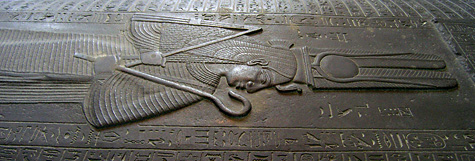

 Hatshepsut being crowned by Amun-Re and granted life and dominion by the goddess “Great in Magic”, from the reconstructed Red Chapel in the Karnak Open Air Museum. An early 18th Dynasty temple at Mut dates to the reign of this woman who ruled as king.
Hatshepsut being crowned by Amun-Re and granted life and dominion by the goddess “Great in Magic”, from the reconstructed Red Chapel in the Karnak Open Air Museum. An early 18th Dynasty temple at Mut dates to the reign of this woman who ruled as king. In scenes of goddesses suckling humans, the human is normally the king, with the scene representing the transfer of life and power. Yet in this scene in the Chapel of Osiris-Ruler-of-Eternity at Karnak, not only is the God’s Wife of Amun, Shepenwepet I, being suckled, she is also wearing 2 Double Crowns, something shown nowhere else in any period.
In scenes of goddesses suckling humans, the human is normally the king, with the scene representing the transfer of life and power. Yet in this scene in the Chapel of Osiris-Ruler-of-Eternity at Karnak, not only is the God’s Wife of Amun, Shepenwepet I, being suckled, she is also wearing 2 Double Crowns, something shown nowhere else in any period. In her funerary chapel at the temple of Medinet Habu, Amunirdis makes offerings to Amun and Hathor. The presence of funerary chapels to mortals within the sacred grounds of a temple is rare until the Third Intermediate Period, a time when God’s Wives of Amun flourished.
In her funerary chapel at the temple of Medinet Habu, Amunirdis makes offerings to Amun and Hathor. The presence of funerary chapels to mortals within the sacred grounds of a temple is rare until the Third Intermediate Period, a time when God’s Wives of Amun flourished. Intangible concepts could also be represented as goddesses. In a scene commemorating an important military campaign by Sheshonq I of Dynasty 22, the goddess “Victorious Thebes”, carrying a mace, an axe and a bow, drags conquered cities (shown as bound prisoners with the city names enclosed in cartouches representing fortified walls) to be slaughtered.
Intangible concepts could also be represented as goddesses. In a scene commemorating an important military campaign by Sheshonq I of Dynasty 22, the goddess “Victorious Thebes”, carrying a mace, an axe and a bow, drags conquered cities (shown as bound prisoners with the city names enclosed in cartouches representing fortified walls) to be slaughtered. Upper and Lower Egypt were represented as the goddesses Nekhbet (right) and Wadjet. Scenes of the king flanked by these protective deities are common in all periods of Egyptian history. This one comes from the Mut Precinct’s Ptolemaic Chapel D.
Upper and Lower Egypt were represented as the goddesses Nekhbet (right) and Wadjet. Scenes of the king flanked by these protective deities are common in all periods of Egyptian history. This one comes from the Mut Precinct’s Ptolemaic Chapel D. Keeping Mut and Sakhmet happy was a main function of the Mut priesthood. In this scene from the Mut Precinct’s main entrance the king (holding Hathor-headed sistra) and two priestesses play music to Mut and Sakhmet to amuse them and keep them contented.
Keeping Mut and Sakhmet happy was a main function of the Mut priesthood. In this scene from the Mut Precinct’s main entrance the king (holding Hathor-headed sistra) and two priestesses play music to Mut and Sakhmet to amuse them and keep them contented.



 And finally, a stela of a king offering to Mut that we uncovered in 2006. While the stela is uninscribed, it is entirely possible that it dates to the reign of the Roman Emperor Tiberius, showing that Mut continued as an important goddess even after Egypt’s conquest by Rome.
And finally, a stela of a king offering to Mut that we uncovered in 2006. While the stela is uninscribed, it is entirely possible that it dates to the reign of the Roman Emperor Tiberius, showing that Mut continued as an important goddess even after Egypt’s conquest by Rome.
You must be logged in to post a comment.